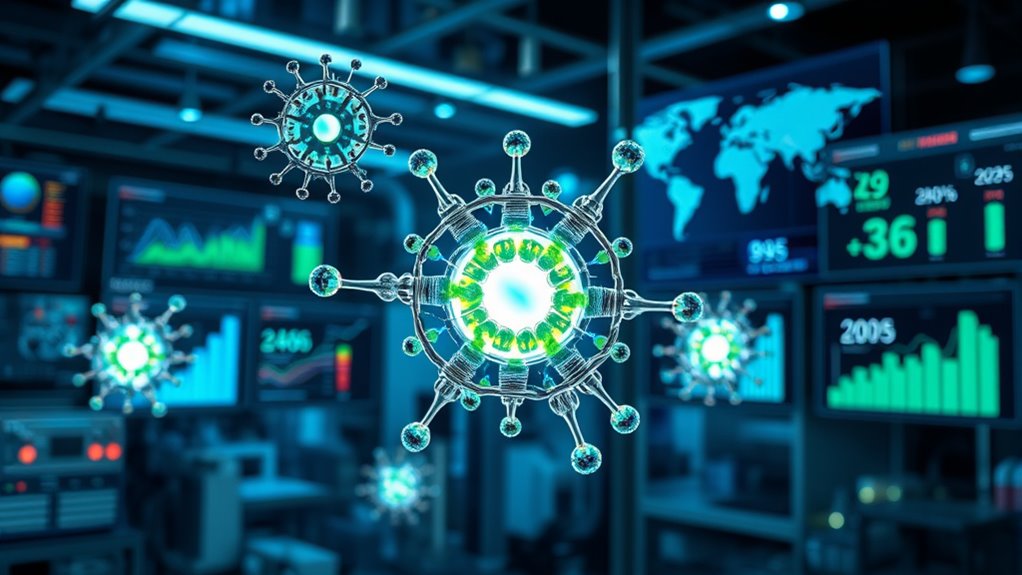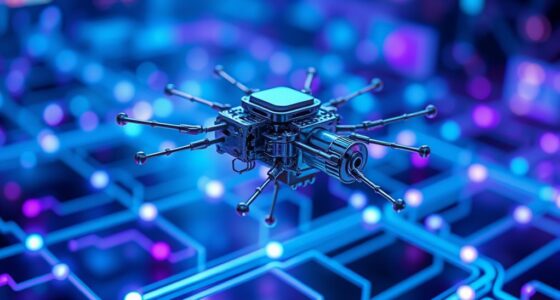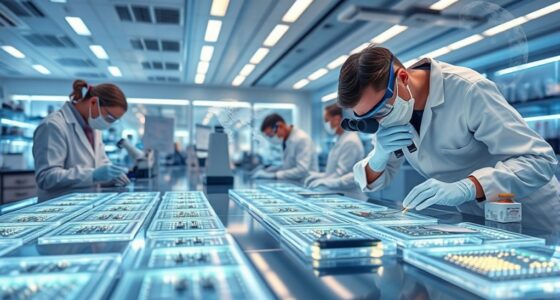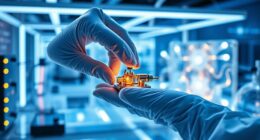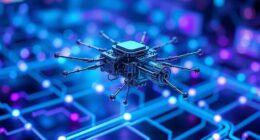The global nanomachines market is expected to grow rapidly from 2025 to 2035, driven by technological breakthroughs and broadening applications across healthcare, manufacturing, and electronics. You can expect advancements in medical treatments like targeted drug delivery, as well as smarter, more efficient production systems. As investments increase and integration with AI continues, nanomachines will become more autonomous and accessible. Stay tuned—there’s much more to explore about how this transformative industry will evolve.
Key Takeaways
- The nanomachines market is expected to experience significant growth driven by advances in nanotechnology, healthcare, electronics, and manufacturing sectors through 2035.
- Increasing investments in R&D will reduce costs and expand accessibility, facilitating broader adoption across industries.
- Integration with AI and robotics will enhance autonomous capabilities, enabling real-time applications in medicine and manufacturing.
- Healthcare applications, including targeted drug delivery and tissue repair, will be major growth drivers in the coming years.
- Continuous technological innovations will lead to more sophisticated, automated, and customizable nanomachine solutions globally.
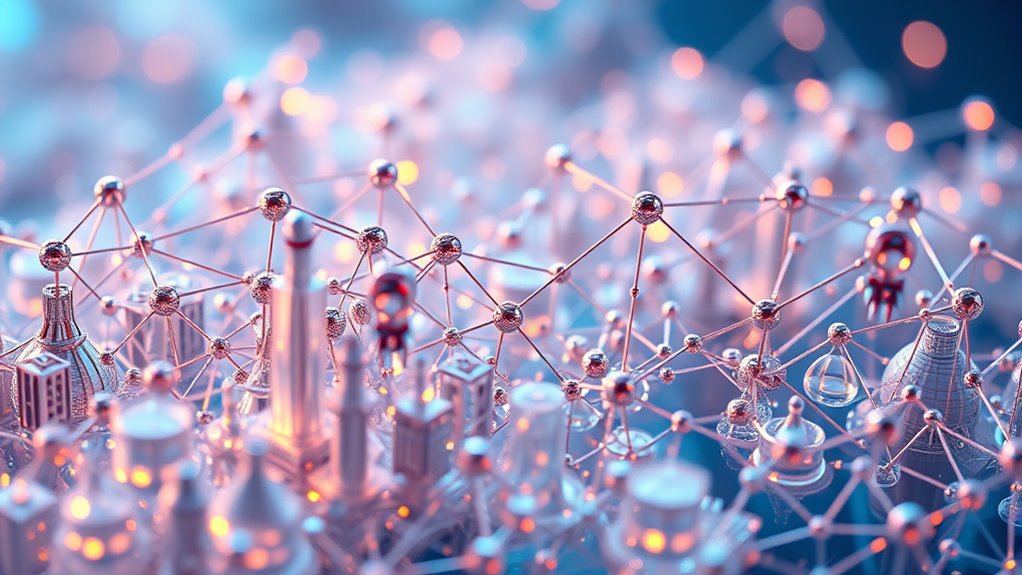
The nanomachines market is poised for significant growth as advancements in nanotechnology drive innovations across healthcare, electronics, and manufacturing sectors. As these tiny machines become more sophisticated, you’ll find their applications expanding rapidly, especially in medicine and manufacturing. In healthcare, nanomachines are revolutionizing how you diagnose, treat, and prevent diseases. They can target specific cells or tissues with remarkable precision, delivering drugs directly to cancer cells or repairing damaged tissues at the cellular level. This targeted approach reduces side effects and enhances treatment efficacy, making therapies more personalized and effective. Researchers are also developing nanomachines capable of steering your bloodstream, seeking out pathogens or abnormal cells, and performing in-situ repairs. These breakthroughs could drastically improve patient outcomes and reduce hospital stays. Additionally, the ability of nanomachines to manipulate materials at the atomic level is a key aspect of their impact on manufacturing, enabling the creation of stronger, lighter, and more durable components. These advancements in manufacturing aren’t just about making things smaller; they’re about making them better, more sustainable, and more customizable. As nanomachines become more commercially viable, you’ll notice a shift toward highly automated, efficient production systems that can adapt quickly to changing demands. The ongoing improvements in nanomachine design and control mechanisms also mean that their applications will become safer and more reliable. You can expect increased investment in research and development, driving down costs and making these technologies accessible across industries. The convergence of nanotechnology with artificial intelligence and robotics further enhances the capabilities of nanomachines, allowing for autonomous operation and real-time decision-making. This synergy will accelerate the deployment of nanomachines in critical areas like healthcare diagnostics, drug delivery, and high-precision manufacturing. The integration of juice cleanse principles into nanomachine processes might seem futuristic, but the focus on precise control and targeted actions aligns with current technological trends. Overall, the coming decade promises a future where nanomachines are deeply embedded in your daily life, transforming industries, improving health outcomes, and enabling new levels of technological innovation.
Frequently Asked Questions
What Are the Biggest Technological Hurdles for Nanomachine Development?
Imagine you’re in a sci-fi movie, but the biggest hurdles for nanomachine development remain real. You face challenges like molecular complexity, which makes designing precise, reliable systems difficult, and manufacturing scalability, where producing nanomachines efficiently on a large scale is tough. Overcoming these issues requires breakthroughs in nanofabrication techniques and better control over molecular interactions, so you can turn futuristic ideas into practical, everyday solutions.
How Will Regulatory Policies Impact Nanomachines Market Growth?
Regulatory barriers and policy frameworks will substantially shape nanomachine market growth. You’ll find that strict regulations can slow innovation by increasing compliance costs, but clear policies provide guidance and boost investor confidence. As regulations evolve, you’ll need to stay updated and adapt your strategies accordingly. Effective policies can foster responsible development, ensuring safety and public trust, which ultimately drives sustainable growth in the nanomachines market.
What Are the Ethical Considerations Surrounding Nanomachine Deployment?
Think of nanomachines as tiny explorers venturing into uncharted territory. You need to contemplate ethical issues like privacy concerns, as these devices could collect sensitive data, and environmental impact, since improper disposal might harm ecosystems. Responsible deployment means establishing clear guidelines to protect individuals’ rights and prevent ecological damage. Ensuring transparency and safety measures helps balance innovation with moral responsibility, safeguarding society from unintended consequences of nanomachine technology.
Which Industries Will Benefit Most From Nanomachine Innovations?
You’ll find that medical applications and environmental remediation benefit most from nanomachine innovations. In healthcare, nanomachines can target and treat diseases at the cellular level, enhancing precision and reducing side effects. For environmental efforts, they can clean pollutants more efficiently. As these technologies evolve, expect significant advancements in both sectors, transforming how you approach health issues and environmental challenges with highly targeted, effective solutions.
How Do Costs of Nanomachine Production Compare Globally?
Ever wondered how production costs influence global pricing of nanomachines? You’ll find that they vary widely depending on the country, technology, and scale of production. In some regions, advanced manufacturing reduces costs, making nanomachines more affordable. But in others, limited infrastructure keeps prices high. Overall, these costs are shifting as technology advances, but disparities still exist, affecting how quickly industries worldwide adopt nanomachine innovations.
Conclusion
As you explore the promising horizon of nanomachines, you’ll find a world quietly transforming, opening subtle avenues for innovation and progress. The journey ahead hints at remarkable advancements, gently steering industries toward more efficient and sophisticated solutions. Embrace this evolving landscape with optimism, knowing that these tiny marvels hold the potential to bring about gentle yet profound improvements to many aspects of life. The future, while delicately unfolding, promises exciting possibilities worth looking forward to.
